Is Tashkent Worth Visiting?
Once the fourth largest city in the Soviet Union and now the most populated city in ex-Soviet Central Asia (home to a whopping 2.3 million people), Tashkent is often overlooked for its windswept and desert-dwelling neighbours. In fact, many might try to persuade you that it’s really just a convenient place to spend the night, withdraw some cash and grab a coffee.
A pit-stop before the real adventure begins.
However, and having recently spent two days in Tashkent, I’d definitely disagree with this view.
Whilst you may not need that much time in Tashkent (we’d suggest that 2 days is more than enough), there’s a surprising amount to see and do.
In and amongst its spacious boulevards and Brutalist, Soviet style architecture, visitors to the city will discover historic mosques, the world’s oldest Quran, a dazzlingly beautiful – and once top secret – metro system, a bazaar overflowing with spices and some of the most beautiful city parks that the world has to offer.
With many Russian citizens moving to Tashkent following the Ukraine conflict, the city has also witnessed an influx of money and with it, a burgeoning cafe culture and more Western-style restaurants (not that you’ll need these). Even boasting its very own ‘Broadway’ – a boulevard filled with sparkling lights and entertainers – Tashkent is a legitimate destination in itself.
If you’re flying into the city, we’d therefore definitely recommend spending at least two days in Tashkent.
To help you get the most out of the city, below is our list the 12 best things to do in Tashkent, Uzbekistan – as well as a mini guide to Tashkent. Prepare to fall unexpectedly in love with this vastly underrated city.
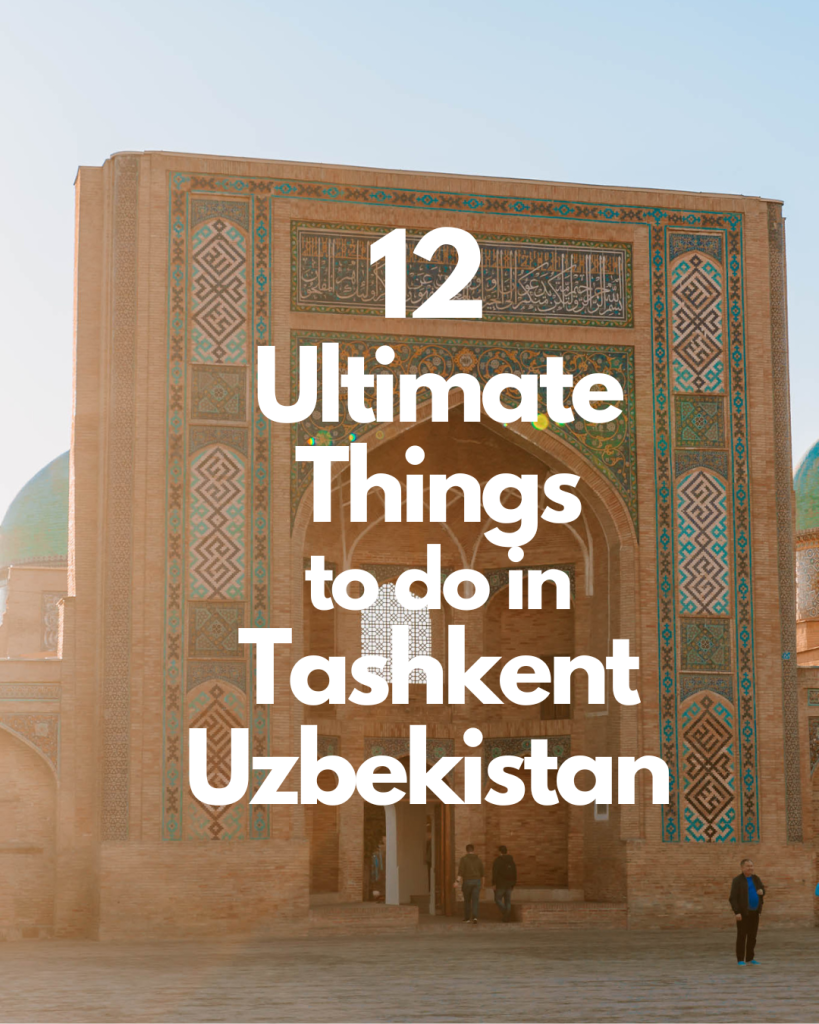
12 Best Things to do in Tashkent, Uzbekistan
Top Attractions in Tashkent
1. Visit Chorsu Bazaar
Let’s begin this Tashkent travel guide with a trip to one of our favourite places in the city – and one of the top attractions in Tashkent – the crowded and hypnotic Chorsu Bazaar.
After a very late arrival into Tashkent and our hotel – the fantastic Central Palace Halal Hotel – we decided to start our trip with an immersive dip into Uzbeki culture; with a visit to the city’s most culturally rich spots.
Found in Tashkent’s Old Town, Chorsu Bazaar can be easily located thanks to its towering green dome, which houses the market’s indoor quarters. Inside, you’ll find Tashkent locals shopping for spices, huge slabs of horse meat and freshly made candy. Continue along its winding pathways and outdoors, and you’ll pass beautifully embroidered sitting cushions (kurpacha) for sale, vibrantly decorated ceramics and intricate gowns.
The Bazaar is a busy and loud place, and an incredible introduction to Tashkent. One of our favourite experiences was simply eating our way through all the local delicacies – cooked outside in the atmospheric food quarter.
With steam pouring from hot grills, and the smell of cooking meats and spices filling the air, this part of the market was incredible. Weaving our way through the crowds, we tried standard Uzbeki fare, including ‘Plov’ (a rice dish, often made with chicken), ‘Somsa’ (pockets of dough stuffed with meat and vegetables) and ‘Shurpa’ (a rich soup), and watched as women dressed in traditional gowns brewed black tea and expertly carved sheep’s heads.
It was an assault on the senses, but a fantastic one.
Food here is also cheap and you can grab a great lunch for as little as £1. A visit here is definitely an unmissable thing to do in Tashkent.
2. Visit Khast-Imam Complex
Next on this list of best things to do in Tashkent, Uzbekistan, is a trip to the utterly beautiful Khast-Imam Complex (visit at sunset, for an extra level of beauty).
Dubbed the spiritual heart of Tashkent, this large complex is home to the Hazrat Imran Mosque, built relatively recently in 2007, the oldest Quran in the world, the tiny Muyi Mubarak Library and the impressive Barak Khan Madrassah (or school).
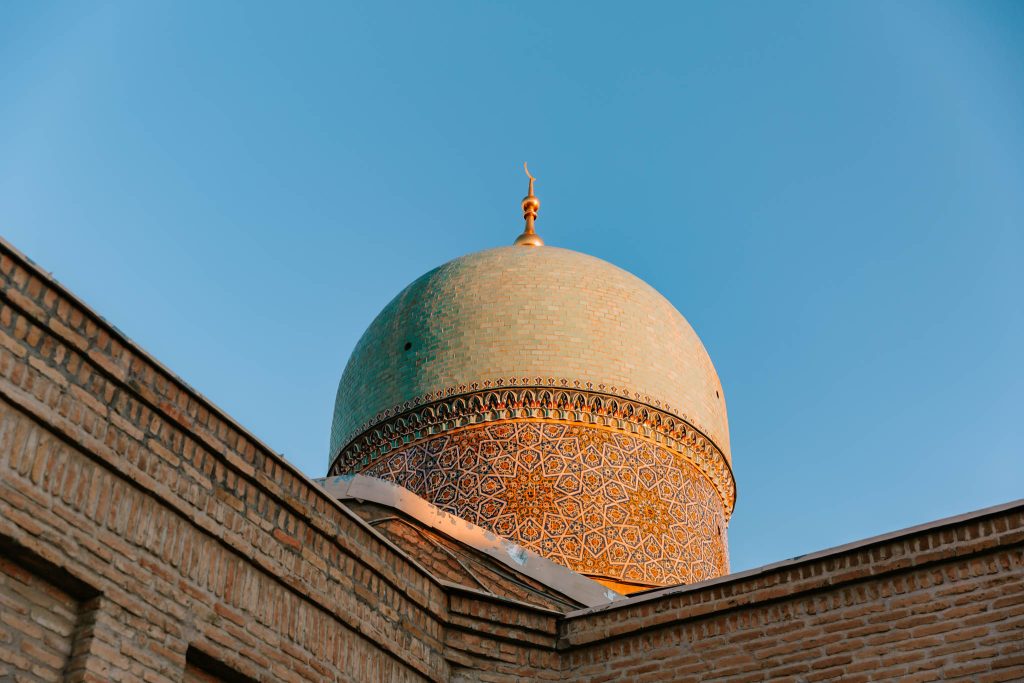 There are also several notable burial sites across the complex, including a beautifully and intricately carved 16th century mausoleum, for Abu Bakr Mohammed Kaffal Shashi (dubbed Uzbekistan’s ‘The Holy Man’).
There are also several notable burial sites across the complex, including a beautifully and intricately carved 16th century mausoleum, for Abu Bakr Mohammed Kaffal Shashi (dubbed Uzbekistan’s ‘The Holy Man’).
It’s worth visiting the complex just to see the ancient Uthman Quran itself – thought to have been written and produced in the 8th century (and claimed to be the oldest Quran in the world). Look closely and you may see the blood splatter of the third Caliph Uthman, who was murdered while reading it in 655.
The entrance fee to visit this library is 30,000 UZS (around £3/ US$3).
We visited the complex at dusk and it was truly magical.
Swallows dove overhead and the sun illuminated the square, making the mosque and its minarets glow and sparkle. Situated a little outside of the city, the complex is an incredibly peaceful and pretty spot – and a top attraction in Tashkent.
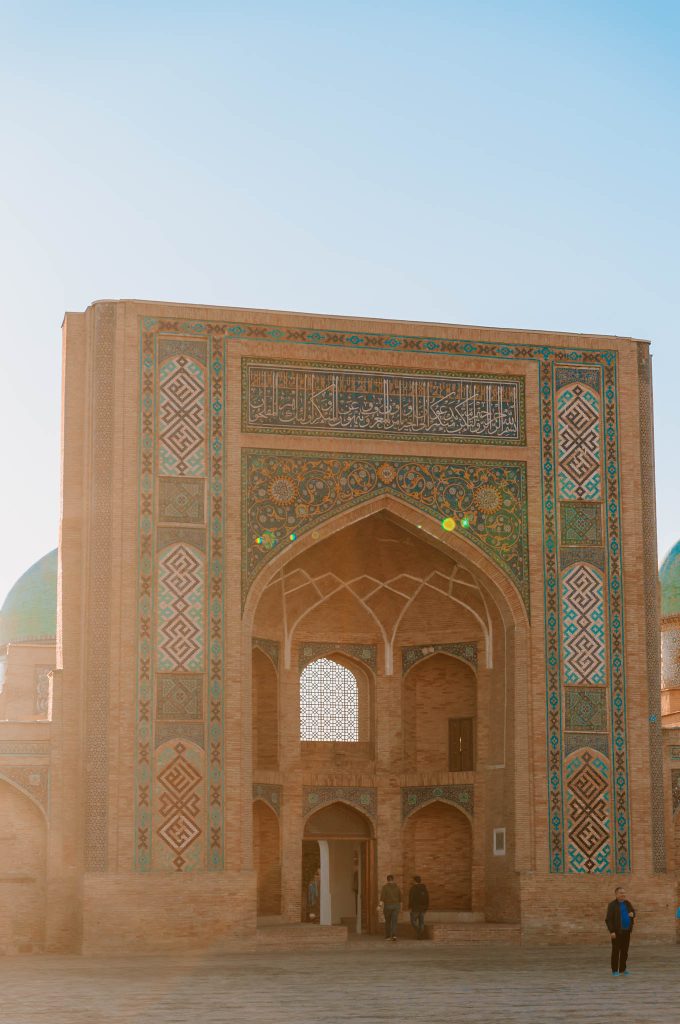
3. Explore Amir Timur Square
Now, if there’s one name you’re going to hear again and again during your time in Uzbekistan, it’s Amir Timur.
Born in 1336, Timur was a Turco-Mongol conqueror, who successfully conquered the expansive Timurid Empire, which spanned Central Asia, Afghanistan and Iraq. Revered as one of the most talented and gifted leaders in history, Timur was also somewhat deadly – and known for his ruthless killing.
Today, Timur’s name is still revered in Uzbekistan and you’ll find it attached to endless buildings and institutions throughout Tashkent, including the magnificent Amir Timur Square.
The Square is surrounded by some of the most important buildings in the country, including the iconic Hotel Uzbekistan, the Forums Palace, the University of Law and Amir Timur Museum. It also features an immaculate park and flowerbeds, and is often filled with locals enjoying a coffee.
Inside the park, you’ll soon come across Tashkent’s famous ‘Tashkent Chime’. Built shortly after World War II, the Chimes sound every 15 minutes, in honour of those who died in World War II and sit in Bolazhon Park, just opposite Amir Temur Square.
4. Explore Tashkent’s Famous and Beautiful Metro System
Definitely one of the best things to do in Tashkent is to explore its world-famous Metro system.
Prior to our own trip to Uzbekistan, we’d heard whisperings of Tashkent’s magnificent metro stations, which had been hidden from the world until 2018.
The system’s first stations were built in 1977 and were soon designated as the city’s bomb shelters (should they be required). As such, it was illegal to share any images of the metro, in case it jeopardised the safety of the site.
However, in 2018, this ban was thankfully lifted and the world was finally able to see the stations for themselves; platforms that far surpass your regular tube stops.
The first metro system in Central Asia, Tashkent’s stations were built to impress; with each station portraying a different style, theme and message. Each tells a distinct part of Uzbekistan’s history, including proud Soviet messaging and stories from Uzbeki culture and folklore.
Viewing all the stations is easy and cheap, as the network is based on just three lines and a trip will cost you as little as £15p. This is a one off fee, regardless of how many stations you plan to visit, which is pretty fantastic.
Today, there are 29 stations, each full of character and their own distinct personality. However, it’s worth noting that some are perhaps a little more special than others.
By far the most famous Tashkent metro station is Kosmonavtlar, which was built to celebrate the USSR’s cosmonauts and their success in the Space Race. As such, the station is filled with a mix of shimmering blue and black tiles, ceramic medallions decorated with sketches of the famous astronauts and a ceiling made of glass stars, to depict the Milky Way.
It’s definitely the best metro station in Tashkent and the most ethereal.
Other stations worth visiting include the stunning Alisher Navoi station, made in honour of a famous Uzbek author, born in the 1400s. Here, beautiful peppermint coloured murals depict scenes from his literature and Uzbeki culture; creating a very romantic atmosphere. On the ceiling, you’ll find decorations representing the country’s famous mosques and madrassas.
Some of the more modern stations are also worth a visit, including one of the last platforms to be built in 2021, Bodomzor.
Definitely be sure to explore the city’s metro system while visiting – it really is one of the best things to do in Tashkent.
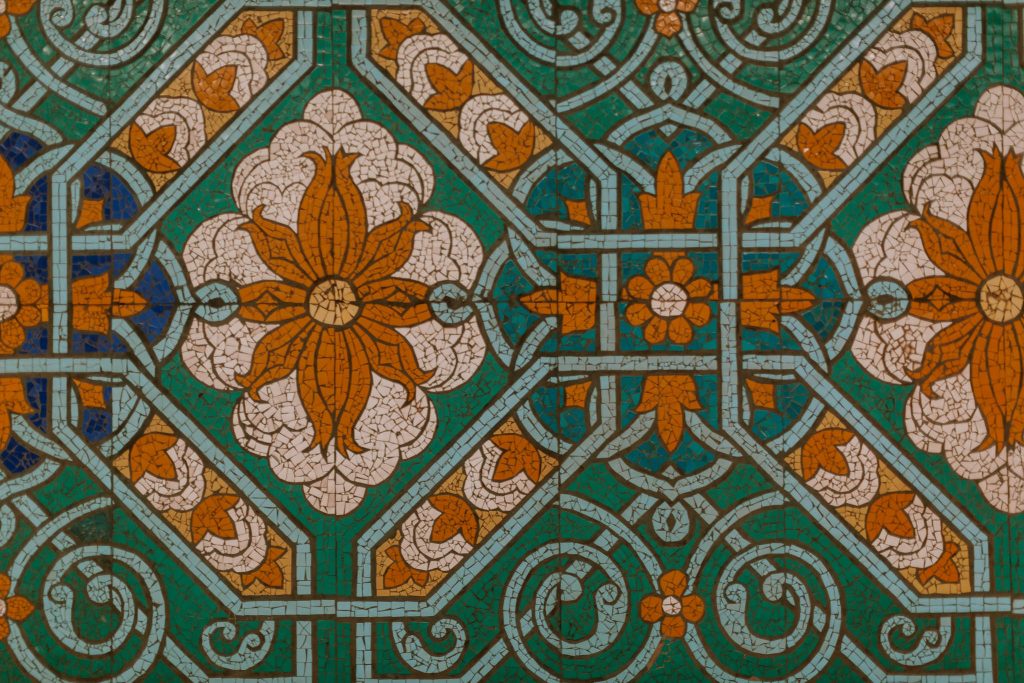
5. Enjoy a Trip to the Navoi Ballet & Theatre
Another for your list of top places to visit in Tashken is the city’s impressive Navoi Theatre.
Opened in 1947, the theatre gained the status of a Bolshoi Theatre, meaning ‘big’ in Russian. It was designed by architect Alexey Shchusev, who also designed Lenin’s Mausoleum and the Kazanskaya Railway Station in Moscow. It’s a truly stunning building, blending that grand Soviet architect with traditional Uzbeki design.
Here, you can catch an opera, or the ballet, for as little as £2 for a balcony seat – which is ridiculously cheap. Each performance lasts around 90 minutes and if you don’t fancy spending the evening there, there are matinee performances available, too.
There is a dress code for the Navoi Theatre and trainers, flip flops and shorts are not permitted. Likewise, try to avoid wearing denim if you can and sports jackets,
By and large, tickets can be purchased on the day from the ‘kassa’ – positioned in front of the theatre and shows rarely sell out.
6. Visit the Palace of Prince Romanov
One of Tashkent’s hidden gems is definitely the Palace of Prince Romanov.
While Tashkent itself feels fairly modern, the sort of place you can’t quite put your finger on when it comes to style or genre, this small corner of the city feels like 19th century Europe.
We visited Tashkent during autumn (perhaps the best time to visit Tashkent), and walked to this pretty palace as the surrounding oak and horse chestnut trees turned a deep red and acorns littered the pathways.
It felt like walking through Paris.
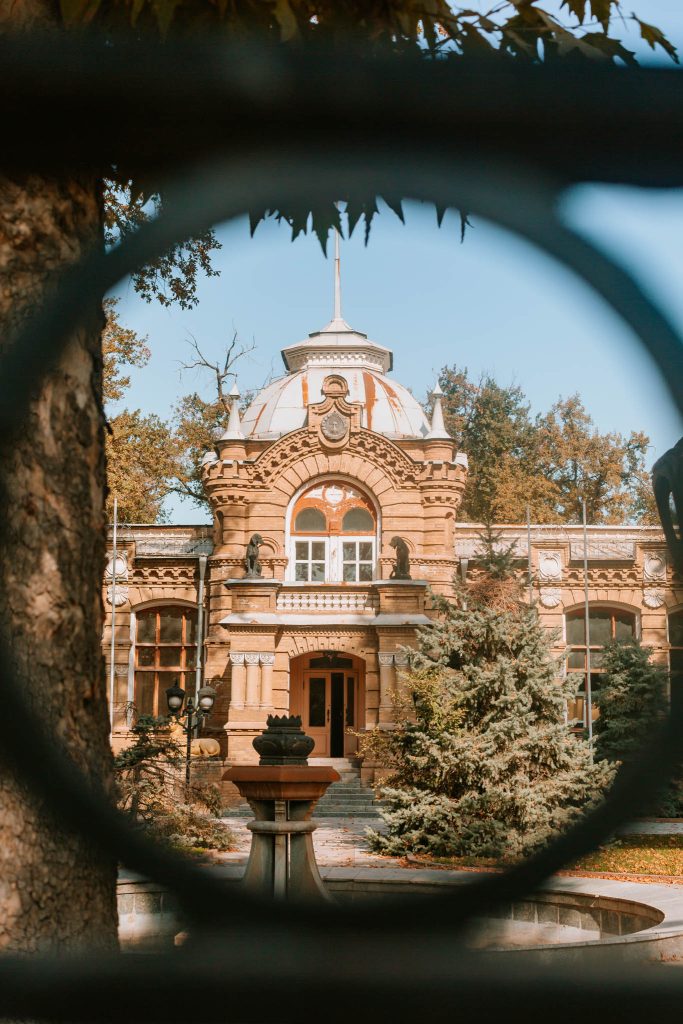
The palace itself is not quite, perhaps, a palace, but instead a pretty, one-storey house, set back behind wrought iron gates and surrounded by beautiful gardens.
The palace was built for Grand Prince Nikolay Konstantinovich Romanov. first cousin of Tsar Nikolay II. Deported to Tashkent in 1881 to mine precious stones, Prince Nikolay had been banished from both his family and his country.
Following a scandalous affair with American Fanny Lear and a subsequent plot to betray his family – culminating in him stealing three diamonds from his mother – Prince Nikolay spent the rest of his life under surveillance in Tashkent, in this beautiful building.
The outline of the building is based on a double-headed eagle, and it’s fronted by two imposing statues of dogs. Once a museum, showcasing the many antiques and treasures amassed by the Prince, the Palace is now sadly shut for renovations (2024).
However, it’s still definitely worth walking by (it’s very close to Amir Temur Square) just to enjoy this unusual little corner of Tashkent.
7. Enjoy Some Traditional Uzbek Bread
During our two days in Tashkent, we were keen to try some of the mouth-watering Uzbek bread we had seen featured in the guidebooks.
Called ‘non’ or ‘lepeshka’, this round, flat bread is a staple part of every Uzbeki meal and is (unsurprisingly) incredibly easy and cheap to get a hold of. Each region within Uzbekistan produces its own version of this bread, with each loaf varying in terms of size, thickness, flavour and density.
Having sampled a few of these breads throughout our week in Uzbekistan, I can confidently say that the ‘non’ produced in Tashkent was my favourite. Famed for its light and airy texture – filled with delicate air pockets – this bread is baked in ‘tandir’ (a traditional Central Asian clay oven), with each loaf stuck to its sides.
If you can, it’s well worth visiting a bakery.
We visited one in Chorsuu Bazaar and were able to head inside to watch the entire baking process in action. Interestingly, it’s only men that are allowed to make the bread, with each baker working on their own station.
Young boys or other workers then add these fresh loaves to their bike baskets and cycle off, back into the steam and chaos of the bazaar.
You can buy the bread there and then, and tuck into it while it’s still steaming hot.
Although not as seasoned or flavoursome as I’d expected, the bread was still delicious and perfect alongside some traditional Uzbek noodles.
8. Visit Tashkent’s Book Bazaar
Definitely one of the top things to do in Tashkent is to browse its pretty book bazaar (luckily it was very close to our hotel).
A sweet little market spanning a tree-lined street, Tashkent’s Book Bazaar is the place to come not just for an eclectic blend of Soviet era and Uzbek books, but for trinkets, vintage items and bric-a-brac.
As a charity shop aficionado, I absolutely loved roaming this market – picking up souvenirs and trinkets to take home. I even managed to find a few vintage toys for my toddler; a little Russian fire engine and car.
I’d definitely note that this isn’t a huge market – not like Chorsuu Bazaar – and is instead a line of stalls that runs down a pedestrianised street, towards the city centre. I’d therefore probably pair it with a visit to the nearby Kosmonavtlar metro station.
9. Visit Hotel Uzbekistan
Prior to our week long tour to Uzbekistan, we spent a little while researching what might await us.
One of the first images that appeared (aside from photos of dazzling blue-tiled mosques), was a building that looked like it had come straight out of a Wes Anderson movie.
Hotel Uzbekistan.
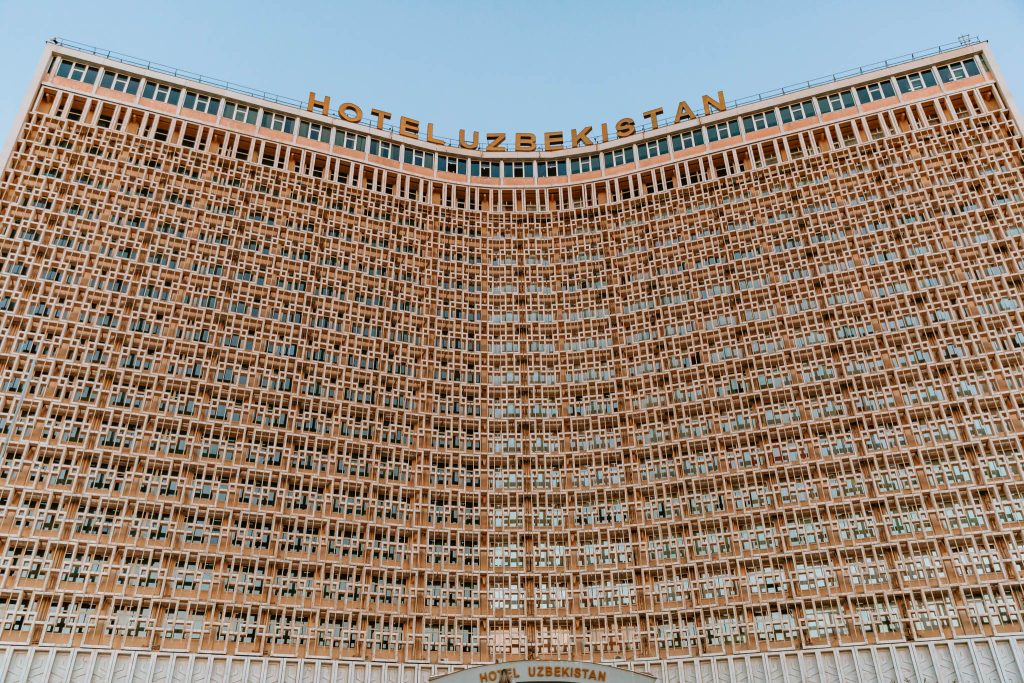
Found in the heart of downtown Tashkent, Hotel Uzbekistan is something of a celebrity in the city; a nod towards the Soviet style architecture that once dominated the capital.
Designed to look like an open book, this dazzlingly symmetrical hotel dominates the horizon and was once the only hotel in Uzbekistan able to accommodate large groups.
Opened in 1974, it’s easy to imagine the hotel in its heyday; a palatial building boasting a ballroom, glittering chandeliers and 254 rooms. Today, it’s perhaps a little frayed around the edges and tired in places, yet nonetheless it provides an insight into Tashkent when it first opened its doors to the world.
If you’re planning on staying in Hotel Uzbekistan, be warned that it’s perhaps just a 3 star hotel (at best) but still fairly priced, at around £60 a night during peak season.
In my opinion, it’s definitely one of Tashkent’s unmissable attractions.
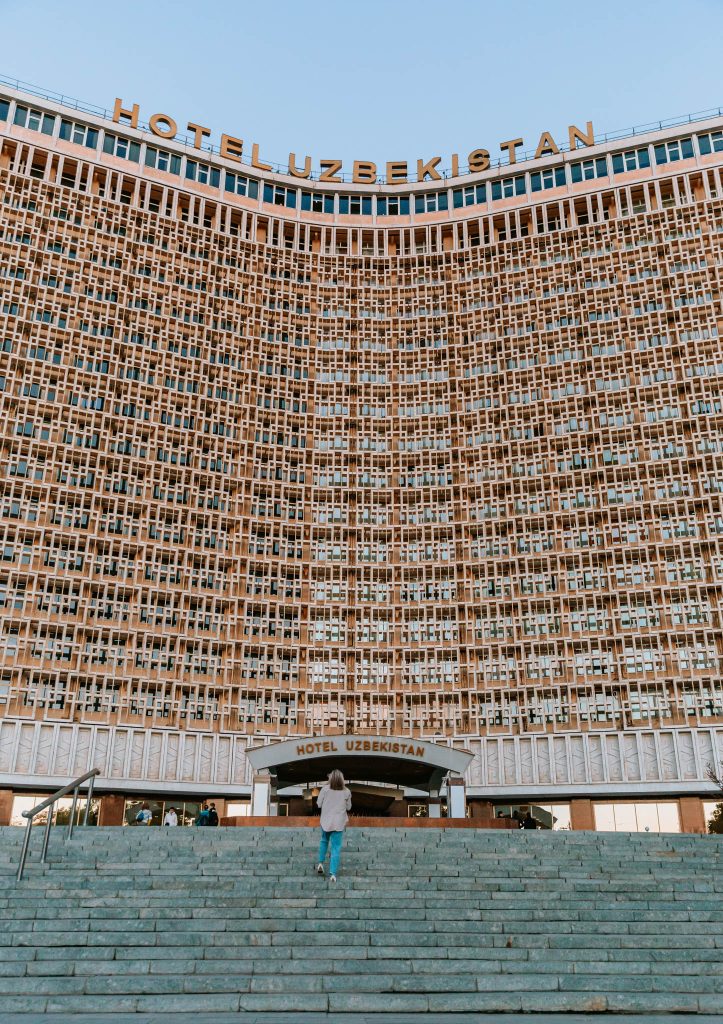
10. Visit Tashkent’s Answer to Broadway
If you’re wondering “does Tashkent have good nightlife?”, look no further than ‘Tashkent Broadway’, otherwise known as Sayilgoh.
Uniting Amir Temur Square and Mustakillik (Independence) Square, this long boulevard comes alive come evening time; filled with lights, chatter, vendors, entertainers and artists.
Decorated with sparkling lights, head here for a quick drink, before exploring the vintage souvenirs on sale, or watch the carousels go round and browse the local stores.
11. Walk Tashkent’s Famous Parks
One thing we definitely hadn’t expected from Tashkent was its number of beautiful, meticulous and peaceful parks. In fact, 35% of Tashkent is green; filled with ancient trees, flower gardens, fountains and memorials.
Each of the 18 parks are fastidiously maintained and during our one day in Tashkent, we regularly saw workers sweeping, pruning and trimming the parkland. They were beautiful spaces to wander in the autumnal sunlight and felt world’s away from the busy Chorsu Bazaar.
Each park is slightly different. Some are geared towards families and have amusements inside, such as Mirzo Ulugbek Park and Tashkent-Land amusement park.
Others are geared towards peace and serenity; a place to catch your breath and relax. Alisher Navoi Park is definitely of this variety and boasts 65 hectares, a lake and multiple streams that run through its grounds. Alternatively, stop by Gafur Gulyam Park – one of the biggest parks in the Republic.
One of the prettiest places in Tashkent was the National War Memorial (or Tomb of the Unknown Soldier), found close to Mustaqillik Maydoni – or Independence Square – in the heart of the city.
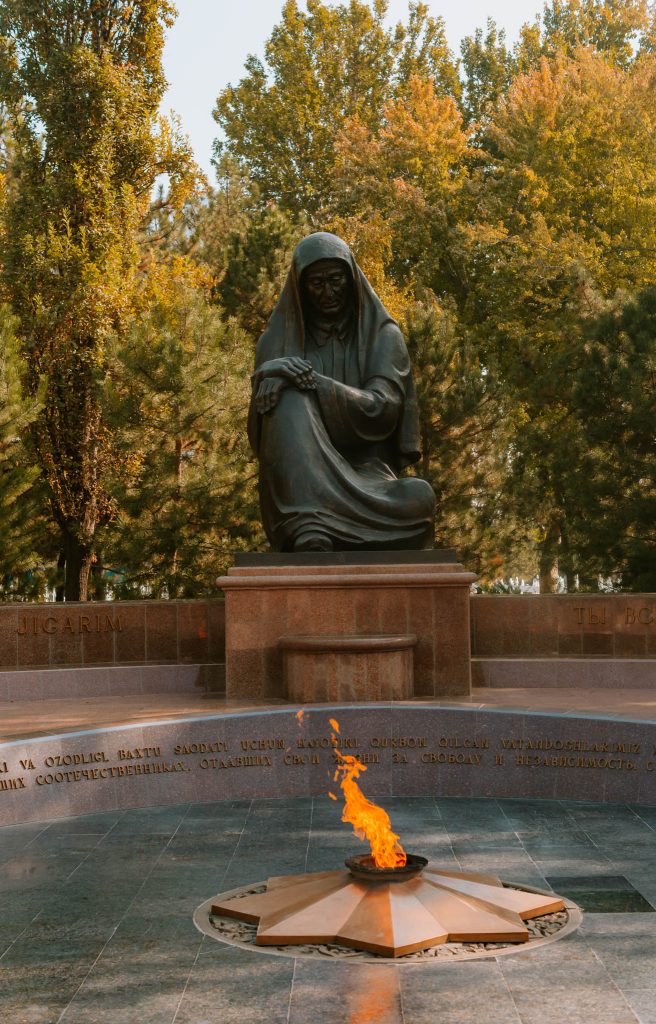
Here, covered in dappled sunlight and the shade of towering horse chestnut trees, stands a stunning memorial that contains the name of every Uzbeki solider who lost their life in WW2. Close by is the Crying Mother monument, representing every mother who lost a son in the war; an eternal flame burning next to her.
The monuments are extremely moving and immaculately maintained. It’s a lovely spot to sit and consider Uzbekistan’s own role in world events and the immense loss they also experienced during the War.
12. Visit a Traditional Tea House or Soviet Diner
One of the best things to do in Tashkent, in my opinion, is to head for a traditional tea house (‘Choyxona’) for breakfast, or to a retro-style Soviet diner for coffee.
We visited several of these during our own time in Tashkent and loved how each offered a different perspective on Uzbek history and culture.

Given our love of all things Wes Anderson, the diners were really fun spots to explore.
Offering a strange, but oddly charming, blend of Soviet memorabilia, Americana and Uzbek food, we loved coming to the diners for a quick and cheap meal.
Our favourite spot was the cute little Bek Bistro.
Tashkent FAQs
Before you head to the city, here’s a mini guide to Tashkent.
From how much spending money you’ll need in Tashkent, to some useful phrases to help you get around, here are some key FAQs about visiting Tashkent.
1. What is the best time of year to visit Tashkent (and Uzbekistan more generally)?
We visited Tashkent during peak season (October), which we think was an ideal time to visit.
The city was perfectly autumnal, with orange and red falling leaves all around, whilst still being remarkably warm. In fact, it was far hotter than we expected, with most of us only needing summer dresses to wear. It was chillier in the early morning and evening, but no more than a light jacket and jeans was needed.
During October, the daily average is 20-22 degrees in the day, dropping to a much chillier 9 – 11 degrees at night.
We’d highly recommend visiting Tashkent in autumn or later spring, to avoid the extreme heat that comes with summer and winter.
What to Wear in Uzbekistan: Packing Tips for Women (2025)
2. Best way to get around Tashkent
Before we start, it’s worth noting that Tashkent is a big city, spanning some 449km squared. As such, it’s probably worth planning your days in Tashkent ahead of time.
Thankfully, and despite its size, getting around Tashkent is very easy. The metro system is not only comprehensive, but super cheap – with entry costing as little last 15p. You can nip across the city quickly and outside of rush hour, the trains are fairly empty (there are also just three lines to navigate).
Alternatively, and whilst Uber isn’t available in Tashkent, the taxi services are cheap and well-established. A two mile fare on average costs as little as £63p, which – compared to most capital cities – is ludicrously cheap.
Unlike other capital cities, Tashkent does not (as of yet, at least) have a particularly developed cycling culture. As such, there are no bike paths and cycling would mean joining the traffic. There are electric scooters throughout the city, although the State have recently tightened their laws surrounding these and you’ll only be able to use one with a driving licence.
Guide to High-Speed Train Travel in Uzbekistan
3. Is Tashkent safe?
Before visiting Tashkent, I had no idea about its resident cultures or atmosphere. A blend of Central Asian heritage and Russian influence, I wasn’t sure if Tashkent would be a city overflowing with crime, or a relatively quiet and safe place for international travellers.
Thankfully, Tashkent is perhaps one of the safest places I’ve visited (and that applies to Uzbekistan more widely). Extremism and violence against visitors remains extremely low and people are incredibly friendly – perhaps the most welcoming folk I’ve come across, in fact.
Furthermore, Uzbekistan recently introduced its own ‘Tourist Police’, whose sole job is to ensure visitors to the country remain safe (they also offer a helping hand when you get lost or need help changing money).
We were truly blown away by the generosity and kindness of the people we met in Tashkent. Travelling as a group of 16 women, we were perhaps stared at occasionally, but this was out of sheer interest and curiosity.
Read our post on whether visiting Uzbekistan is safe as a female traveller
4. What language is spoken in Tashkent? Is English widely understood in Tashkent?
Throughout Tashkent, you’ll find two languages spoken – Uzbek and Russian.
Uzbek is the official language and spoken by some 25 million people throughout the country. Russian is the country’s second language and is spoken by most residents who lived there during the Soviet rule.
Uzbek belongs to the Turkic group of languages and although difficult, we still managed to learn a few key phrases.
English is not widely spoken in Tashkent but when we weren’t with our guide, we didn’t struggle to get around. You’ll find that those working in tourism (i.e. hotels and bars) will speak basic English, as well as the younger generations in the city.
In local markets or taxis, English isn’t spoken as widely but you can get around this with apps like Yandex Taxi (like Uber) and Google Translate.
If you’re worried about getting by in Tashkent, it might be useful to learn some basic Uzbek phrases. Here’s 10 handy suggestions below:
- Salom – sah-LOHM (Hello)
- Rahmat – RAHH-maht (Thank you)
- Iltimos – eel-tee-MOHS (Please)
- Ha / Yo‘q – HAH / YOHK (Yes / No)
- Kechirasiz – keh-chee-RAH-seez (Excuse me / Sorry)
- Bu nech pul? – boo neech POOL (How much is this?)
- Hisobni bering – hee-SOHB-nee BEH-reeng (The bill, please)
- Taksi – TAK-see (Taxi)
- Qayerda…? – KAI-ehr-dah (Where is…?)
- Ingliz tilida gapirasizmi? – EENG-leez tee-LEE-dah gah-pee-RAH-seez-mee (Do you speak English?)
5. How many days do you need in Tashkent?
As we mentioned above, we would say that 2 days in Tashkent would be more than enough.
In the end, we opted for two days in Tashkent and are really glad we did, as it meant we could explore Tashkent’s main attractions at a more leisurely pace (rather than hurtling about on the metro all day). It also meant we could go for dinner in the city and enjoy the ballet, without having to leave too early (we can highly recommend Caravan in Tashkent for a great meal).
6. Where to stay in Tashkent
Tashkent is well set up for tourists and it isn’t hard to find a great hotel on a modest budget.
We stayed at Central Palace Hotel, Tashkent that was located in a leafy part of the city and provided large rooms, with park views and a great breakfast.
Best areas to stay in, in Tashkent
Amir Timur Square & surroundings: very central and near the cafes, theatres and parks.
Navoi Theater / Theatre Square area: easy transport options and near culture/theatres
Old City / Chorsu Bazaar / Hazrati Imam Complex: for a more ‘traditiona’ Uzbek feel
Tashkent City Park / Mirabad: ideal for more modern stays or those travelling for business or with families.
Top Hotels in Tashkent
| Hotel | Class / Style | Highlights |
|---|---|---|
| InterContinental Tashkent | Luxury / 5-star | Modern amenities, rooftop bar, top ratings |
| Hilton Tashkent City | Luxury / 5-star | Stylish, great views, central location |
| Hyatt Regency Tashkent | Luxury / 5-star | Excellent facilities, central, very comfortable |
| Ichan Qal’a Premium Hotel | Luxury / Boutique | Traditional Uzbek décor, very atmospheric |
| Mirzo Boutique Hotel | Boutique / Mid-luxury | Charming, high ratings, close to Old City |
| Holiday Inn Tashkent City | Upscale / Chain | Modern, reliable comfort, good reviews |
| Hotel Uzbekistan | Mid-range / Iconic | Historic, central location, budget-friendly |
7. Is Tashkent cheap or expensive?
Tashkent is not considered an expensive city compared to many European or Western destinations. We found that food, transportation, and accommodation were really affordable, with budget meals starting from just a few pounds and comfortable mid-range hotels offering excellent value.
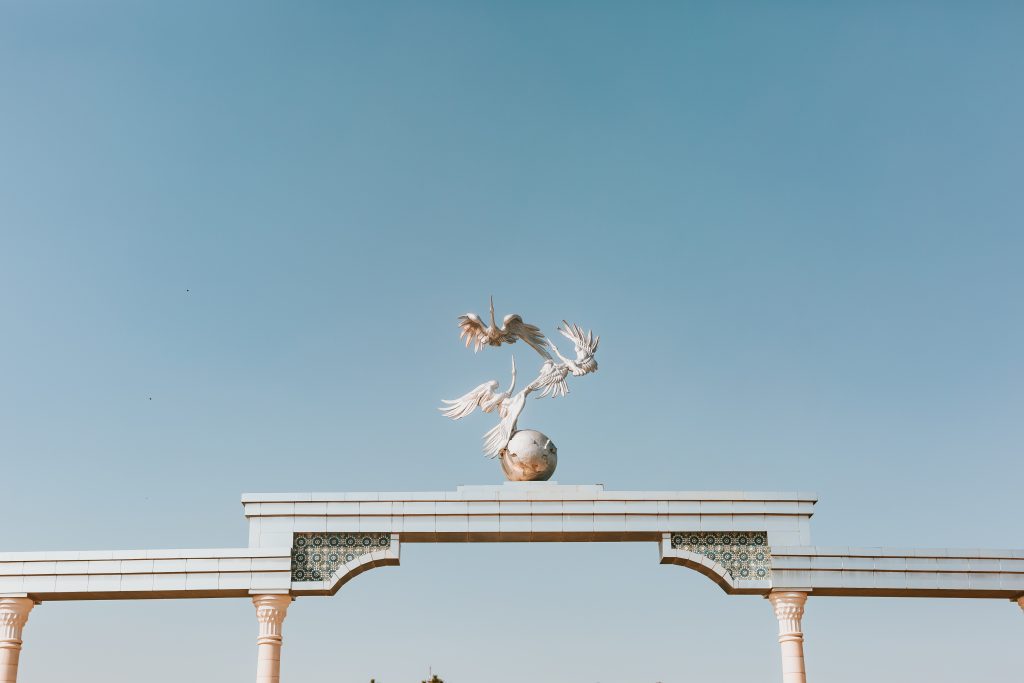
Even top attractions such as museums, bazaars and cultural sites have low entrance fees, making sightseeing very budget-friendly. In fact, I think during our two days in the city, I spent less than £50 – and that included one fairly expensive dinner out at a more ‘fine-dining’ restaurant.
8. Best places to eat in Tashkent
For traditional Plov in Tashkent
If you’re looking for traditional Plov in Tashkent, head to the aptly named Central Asian Plov Centre. Here, you can witness the traditional cooking process as plov is prepared in massive cauldrons over open flames, offering a genuine taste of Uzbek culinary heritage.
During our visit, we were treated to huge portions of plov and enjoyed the fact the Centre was just as busy with locals as it was tourists.
For international cuisine in Tashkent
We had the dreamiest of final dinners at Caravan in Tashkent, in the enchanting outdoor courtyard. Here, you can enjoy a mix of local and international dishes at really good prices. I’d recommend coming here for dinner, when the fairy lights twinkle through the trees and candles flicker across the table.
For lunch on a budget in Tashkent
If you’re really looking to get your moneys worth, have lunch at the Chorsu Bazaar. Here, we enjoyed the most delicious Uzbek dumplings for literally pennies, and freshly made bread and sweet treats.
In fact, I think my whole lunch cost me just £2.50 and kept me more than full for the rest of the afternoon.
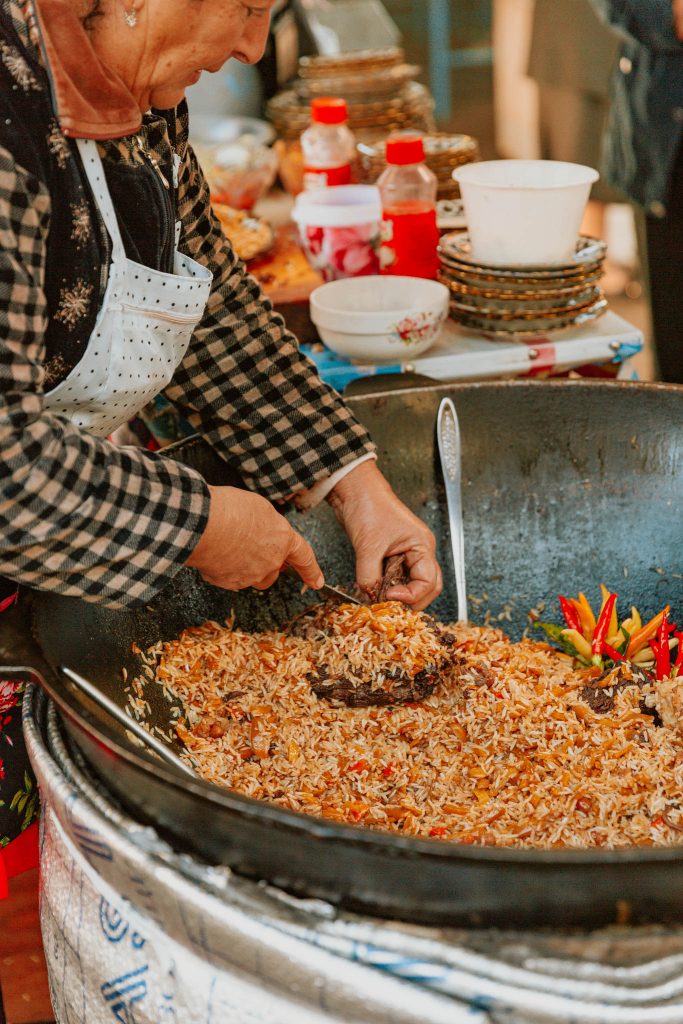
Is Tashkent Really Worth Visiting? My Honest Opinion
Despite this list of the best things to do in Tashkent, you still might have some doubts as to whether it’s worth visiting this capital city.
Uzbekistan is a vast country and with blue-hued Samarkand and windswept Khiva beckoning, it can be tempting to skip Tashkent altogether; jumping on a train and heading for the country’s vast plains.
In our opinion, this would be a mistake.
Yes, Tashkent may not be as photogenic, or atmospheric as other cities in Uzbekistan, but it’s still a culturally rich and incredibly interesting place to explore. The regular contrast between grey Soviet high-rise buildings, and ancient mosques or bazaars, makes this a surprising and unpredictable city; much more than perhaps Bukhara or Samarkand.
A true melting pot of a destination, Tashkent may be modern in its outlook, but it still preserves a very real and important legacy; and one absolutely worth experiencing.
Pin for later: Top Attractions in Tashkent, Uzbekistan







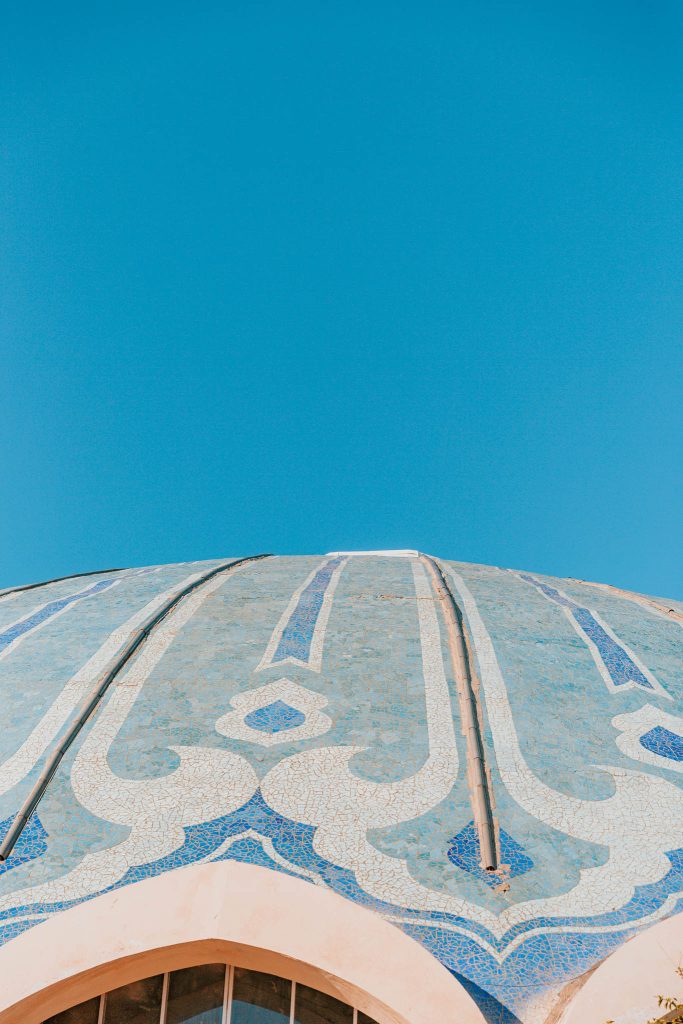






















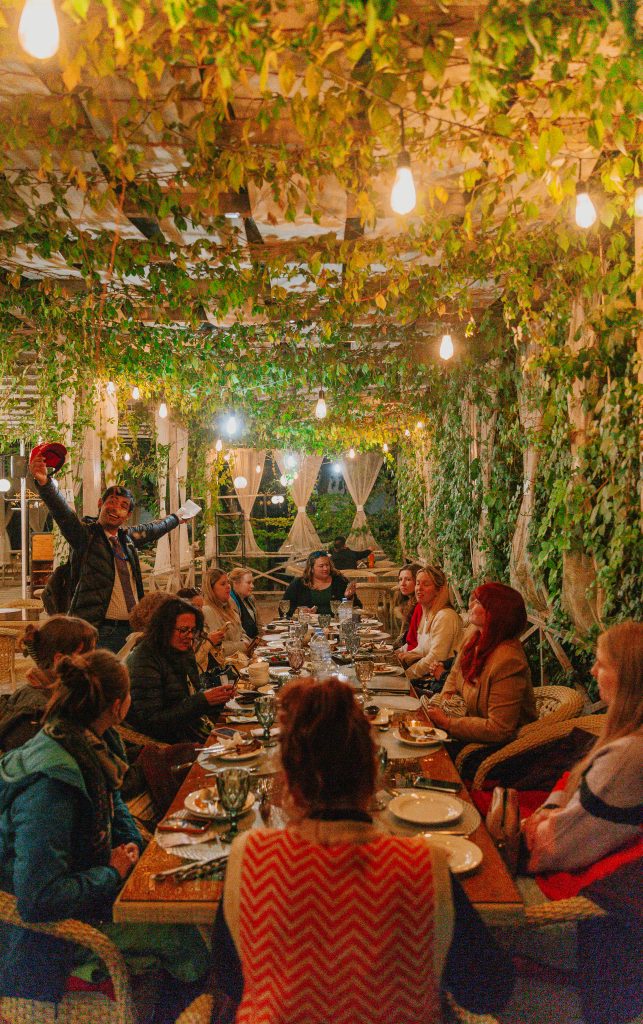
2 comments
Qué buen artículo! Y las fotos tienen mucho sentimiento ???????? Aunque sólo un día me parecr ir demasiado deprisa!
Yo ahora mismo estoy terminando mi viaje por Kazajistán y en apenas 1 semana cruzo a Uzbekistán. Me ha servido mucho tu blog. Gracias!!!
Great article! Could you please tell me which street the book bazaar is? or how to find it? Thank you so much!